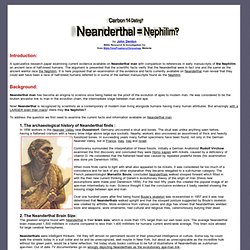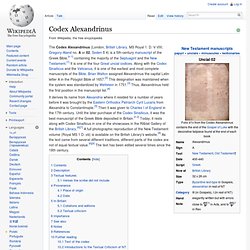

120 Million year old map! 120 Million Year Old Map Found - Proof Of Ancient Civilization The Map Of 'The Creator' A discovery by Bashkir scientists contradicts all traditional notions of human history: stone slabs which are 120 million years old and covered with the relief map of the Ural Region.

This seems to be impossible. Ancient Mystery Alternative History Directory. Neanderthal = Nephilim? By John Denton Bible Research & Investigation Co from BibleTimeProphecyChronology Website Introduction: A speculative research paper examining current evidence available on Neanderthal man with comparison to references in early manuscripts of the Nephilim an ancient race of half-breed humans.

The Biological Basis of Elitism and "The Divine Right" Rule. By Tracy R.

Twyman from ImplosionGroup Website October 28th, 1998, a number of newspapers across the country ran an Associated Press article entitled "Presidential Hopefuls Share Blue Blood Lines. " The article, based on information put forth by Burke’s Peerage, claims that every single President of the United States has had a notable amount of royal European ancestry, and in each Presidential race, the one with the most royal genes is the one who wins - every single time.
This tendency has been noted in supposedly Democratic European politics as well, prompting some to charge that a global conspiracy exists to keep power within the hands of a specific gene pool. This charge is not entirely baseless, and many books have been written tracing the modern aristocratic bloodlines back to the royal houses of Israel, Egypt, Sumer, and beyond. This dates back to the 17th century and states that a king is created by God, and kingly authority resides in the blood irrespective of anything else. 3114 BC. 12,000 Years Old Unexplained Structure Video. Log in Civilization Cynthia Yildirim 12,000 Years Old Unexplained Structure Göbekli Tepe, is a hilltop sanctuary erected on the highest point of an elongated mountain ridge some 15 km northeast of the town of Şanlıurfa, in southeastern Turkey and 500 miles away from Istanbul, Turkey.

It is the most astonishing archaeological discovery in modern times and also thought to be the oldest advanced civilization on Earth. posted 3 years ago jimun gimm liked this ben liked this dpritch liked this Shannon Loggins liked this Tyler Terrell liked this Yogesh Mankani liked this moseljack liked this © 2014 Redux, Inc. About redux | contact us | copyright | legal. Gobekli Tepe: The World’s First Temple? Cain is not in Adam's bloodline. You learned in Genesis chapter three that Satan's seed, through Eve, produced Cain and that Adam's seed brought forth Able. They were maternal twins with different fathers and now it is time for you to learn what effect these two bloodlines may have on you. Satan's seed brought Cain's Kenites and Able came through Adam's seed. However, Cain ended Able's bloodline when he slew him. With proper charting, many of you can trace your Anglo-Saxon bloodline back to Adam and Eve. Able is excluded because he was slain before he fathered children.
Kenite. "Kenite" is a rendition of Hebrew קֵינִי Qeyniy. According to Gesenius, the name is derived from the name Cain (קַיִן Qayin).[5] According to A. H. Sayce, the name `Kenite', Qéní, is identical an Aramaic word meaning `a smith', which in its turn is a cognate of Hebrew Quayin, with the meaning `a lance'.[6] In the Bible[edit] Anax. Archaic inscription [...]Ι ϜΑΝΑΚΤΙ ([...]i wanakti, "to the king") on ceramic fragment, here shown upside down; a warrior bearing a spear and mounted on a horse is also depicted. Anax (Greek: ἄναξ; from earlier ϝάναξ, wánax) is an ancient Greek word for "(tribal) king, lord, (military) leader".[1] It is one of the two Greek titles traditionally translated as "king", the other being basileus.
Anax is the more archaic term of the two, inherited from the Mycenaean period, and is notably used in Homeric Greek, e.g. of Agamemnon. The feminine form is anassa, "queen" (ἄνασσα, ánassa; from wánassa, itself from *wánakt-ja).[2] Etymology[edit] Anak. Anak (/ˈeɪˌnæk/; Heb. 'nq spelt as both ענק and as הענק depending upon the reference) was a well-known figure during the conquest of Canaan by the Israelites who, according to the Book of Numbers, was a forefather of the Anakites[1][2] (Heb.

Anakim) who have been considered "strong and tall," they were also said to have been a mixed race of giant people, descendants of the Nephilim (Numbers 13:33). The use of the word "nephilim" in this verse describes a crossbreed of God's sons and the daughters of man, as cited in (Genesis 6:1-2) and (Genesis 6:4). Codex Alexandrinus. It derives its name from Alexandria where it resided for a number of years before it was brought by the Eastern Orthodox Patriarch Cyril Lucaris from Alexandria to Constantinople.[5] Then it was given to Charles I of England in the 17th century.

Until the later purchase of the Codex Sinaiticus, it was the best manuscript of the Greek Bible deposited in Britain. [n 2] Today, it rests along with Codex Sinaiticus in one of the showcases in the Ritblat Gallery of the British Library.[6][7] A full photographic reproduction of the New Testament volume (Royal MS 1 D. viii) is available on the British Library's website.[8] As the text came from several different traditions, different parts of the codex are not of equal textual value.[6][9] The text has been edited several times since the 18th century. Contents[edit] Colophon at the end Epistle of Jude. According to this colophon Acts of the Apostles follows General epistles. Tartarus. Greek mythology[edit] In Greek mythology, Tartarus is both a deity and a place in the underworld.

In ancient Orphic sources and in the mystery schools, Tartarus is also the unbounded first-existing entity from which the Light and the cosmos are born. As for the place, Hesiod asserts that a bronze anvil falling from heaven would fall nine days before it reached the earth. Nephilim. Etymology[edit] In the Hebrew Bible[edit] The term "Nephilim" occurs just twice in the Hebrew Bible, both in the Torah.

The first is Genesis 6:1–4, immediately before the story of Noah's ark. Ogias the Giant. Azazel. Mount Azazel (Jabel Muntar) in the Judean Desert, to which the goat was sent, and from which it was pushed. Cliffs of Mount Azazel (Jabel Muntar). Azazel [ə-ˈzā-zəl] or Azazael or Azâzêl (Hebrew: עֲזָאזֵל, Azazel; Arabic: عَزازِيل, Azāzīl) is a term used three times in the Hebrew Bible, which has been traditionally understood either as a scapegoat, or in some traditions of Judaism, Christianity, and Islam, as the name of a fallen angel or demon. Hebrew Bible[edit] The term in the Bible is limited to three uses in Leviticus 16, where two he-goats were sacrificed to God and one of two he-goats got a lot, reading לַעֲזָאזֵל la-aza'zeyl; either "for absolute removal" or "for Azazel" and outcast in the desert as part of the Day of Atonement, for God is seen as speaking through lottery.[1] Leviticus 16:8–10 reads: Later rabbis, interpreting "la-azazel" as "azaz" (rugged), and "el" (strong), refer it to the rugged and rough mountain cliff from which the goat was cast down (..)[2][3][4]
Enoch (ancestor of Noah) Enoch appears in the Book of Genesis of the Pentateuch as the seventh of the ten pre-Deluge Patriarchs. Genesis recounts that each of the pre-Flood Patriarchs lives for several centuries, has a son, lives more centuries, and then dies. The exception is Enoch, who does not experience death "for God took him. " Furthermore, Gen 5:22-29 states that Enoch lived 365 years which is extremely short in the context of his peers. The brief account of Enoch in Genesis 5 ends with the note that he "was no more" and that "God took him. " Three extensive apocryphal works are attributed to Enoch: